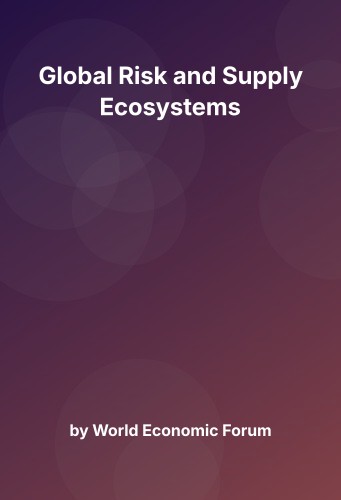Navigating Global Risks in Supply Ecosystems: Strategic Insights
In the rapidly evolving landscape of global business, understanding and managing risk within supply ecosystems is crucial. The World Economic Forum’s “Global Risk and Supply Ecosystems” provides a comprehensive exploration of these challenges, offering professionals the strategic frameworks and insights necessary to navigate this complexity. This summary distills the book’s core themes into actionable strategies, emphasizing transformation and adaptability in the face of global uncertainties.
Understanding the Global Risk Landscape
The book begins by mapping the current global risk environment, highlighting the interconnected nature of risks that businesses face today. From geopolitical tensions to climate change and technological disruptions, the modern risk landscape is characterized by its complexity and unpredictability. The World Economic Forum underscores the importance of a holistic view, urging professionals to consider how these risks intersect and amplify each other.
Strategic Risk Management Frameworks
To address these challenges, the book introduces several strategic frameworks for risk management. One such model is the “Integrated Risk Management Approach,” which encourages organizations to break down silos and foster cross-functional collaboration. This approach aligns with concepts from Michael Porter’s value chain analysis, emphasizing the need to integrate risk management into every aspect of the business process.
The book also discusses the importance of scenario planning, a tool that allows businesses to anticipate potential futures and develop flexible strategies. By drawing parallels with Nassim Nicholas Taleb’s “Black Swan” theory, the book highlights the necessity of preparing for unexpected, high-impact events.
Core Frameworks and Concepts
The World Economic Forum introduces a multifaceted framework designed to guide businesses through the intricacies of global risks and supply ecosystems. This framework is not merely theoretical but provides a practical roadmap for implementation. It consists of several key components:
1. Integrated Risk Management
This approach emphasizes the dismantling of silos within organizations to foster cross-functional collaboration. By doing so, companies can achieve a holistic understanding of risk that permeates every level of operation. For example, a company might integrate risk management in supply chain logistics by employing cross-departmental teams to anticipate disruptions and devise mitigation strategies.
2. Scenario Planning
Scenario planning is a critical tool for visualizing potential futures. By creating detailed scenarios, companies can prepare for a variety of outcomes. This is akin to military strategy exercises, where different battle scenarios are simulated to test responses and refine tactics.
3. Building Resilient Supply Ecosystems
The shift from traditional supply chains to resilient supply ecosystems is imperative. This is achieved through agility, transparency, and technological integration. For instance, adopting blockchain technology can provide transparency and traceability, ensuring that all stakeholders are informed and accountable.
4. Digital Transformation
Digital tools enhance decision-making and operational efficiency. Through data analytics, organizations can gain valuable insights into risk patterns, enabling them to optimize their strategies. A real-world analogy can be found in weather forecasting, where data analysis is used to predict and prepare for climatic changes.
5. Leadership and Collaboration
Effective leadership is crucial in navigating global risks. Leaders must cultivate adaptability, strategic foresight, and a culture of innovation. This is reminiscent of the “Level 5 Leadership” model in Jim Collins’ “Good to Great,” where the focus is on humility and resilience for long-term success.
Key Themes
The book delves into several themes critical for understanding and managing global risks in supply ecosystems. Each theme is explored in depth, providing insights that are both strategic and practical.
1. The Interconnected Nature of Risks
Global risks are rarely isolated. The book emphasizes that geopolitical tensions, climate change, and technological disruptions often interact in complex ways. This interconnectedness can exacerbate individual risks, creating a cascading effect. For example, a geopolitical conflict may disrupt supply chains, which in turn could impact technological infrastructure.
2. The Role of Technology in Risk Management
Technology serves as both a tool and a challenge in risk management. Digital transformation can enhance efficiency and decision-making, but it also introduces new vulnerabilities, such as cybersecurity threats. By leveraging AI and blockchain, companies can improve visibility and traceability across their supply networks. This mirrors the insights from Andrew McAfee and Erik Brynjolfsson’s “Machine, Platform, Crowd,” which discusses the transformative power of technology in business.
3. Sustainability as a Risk Management Strategy
Sustainability is not just an ethical consideration but a strategic one. The book advocates for environmentally friendly practices, aligning with the principles of corporate social responsibility. This approach is similar to the ideas presented in “The Responsible Company” by Yvon Chouinard and Vincent Stanley, where sustainability is integral to long-term business success.
4. Collaboration as a Risk Mitigation Tool
Collaboration across sectors and industries is essential for effective risk management. By pooling resources and expertise, businesses can address shared challenges more efficiently. This collaborative approach is akin to the “co-opetition” strategy discussed by Adam Brandenburger and Barry Nalebuff, where companies work together to create mutual value.
5. Ethical Implications of Supply Chain Decisions
The ethical dimensions of supply chain management are increasingly important. Companies must consider the social impact of their operations, ensuring they uphold ethical standards. This aligns with the growing trend of conscious capitalism, where businesses strive to balance profit with purpose, as explored in John Mackey’s “Conscious Capitalism.”
Final Reflection
The World Economic Forum’s “Global Risk and Supply Ecosystems” offers a comprehensive guide for navigating the complexities of modern business environments. By synthesizing insights from various domains, the book provides a multidimensional perspective on risk management. Professionals are encouraged to adopt a future-ready mindset, characterized by agility, innovation, and proactive risk management.
This comprehensive approach is akin to the ideas presented in “The Lean Startup” by Eric Ries, where adaptability and rapid iteration are key. By integrating these principles across leadership, technology, and ethical considerations, businesses can position themselves for long-term success. The book serves as both a guide and a call to action, urging organizations to transform their supply ecosystems and embrace the opportunities presented by an ever-changing world.

